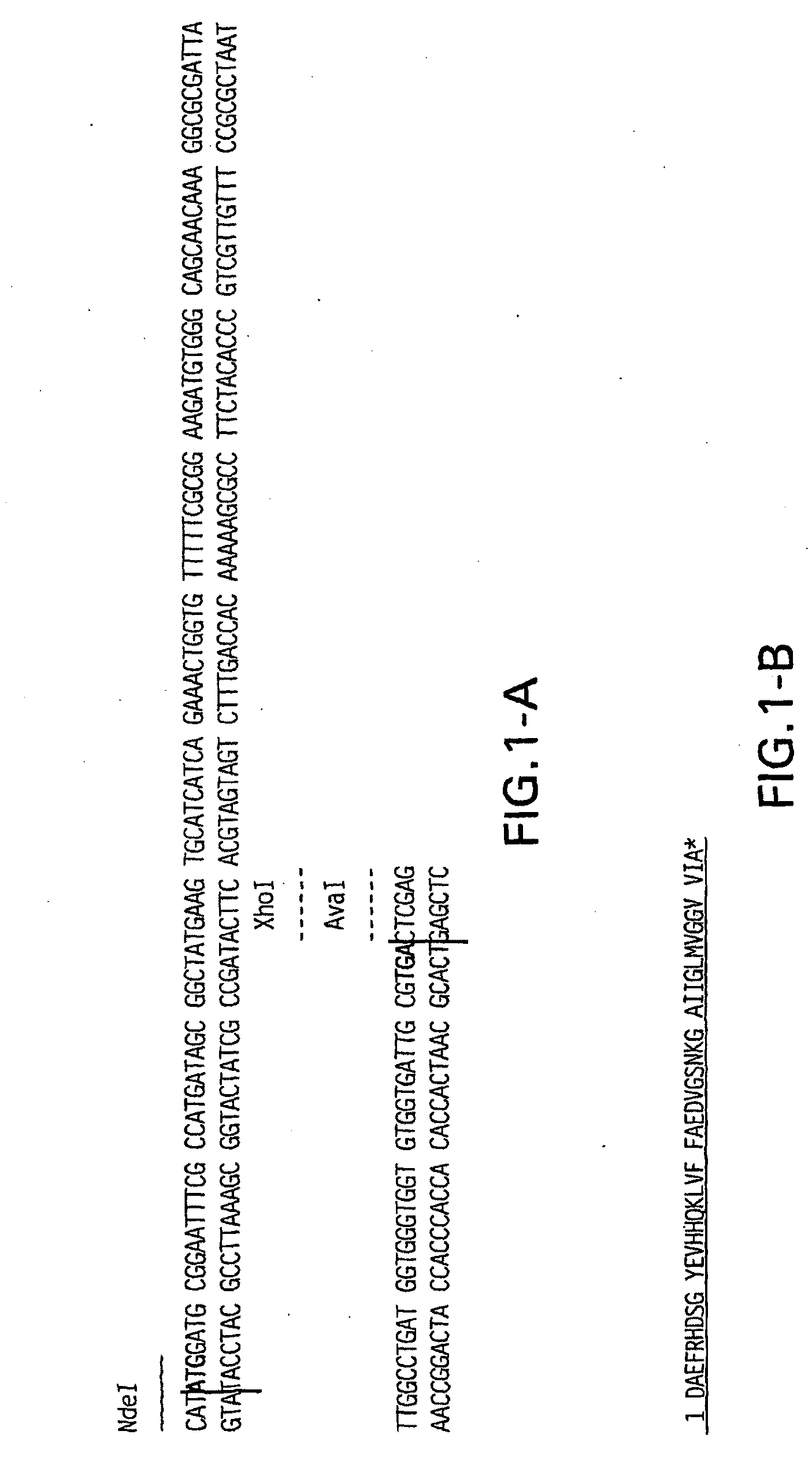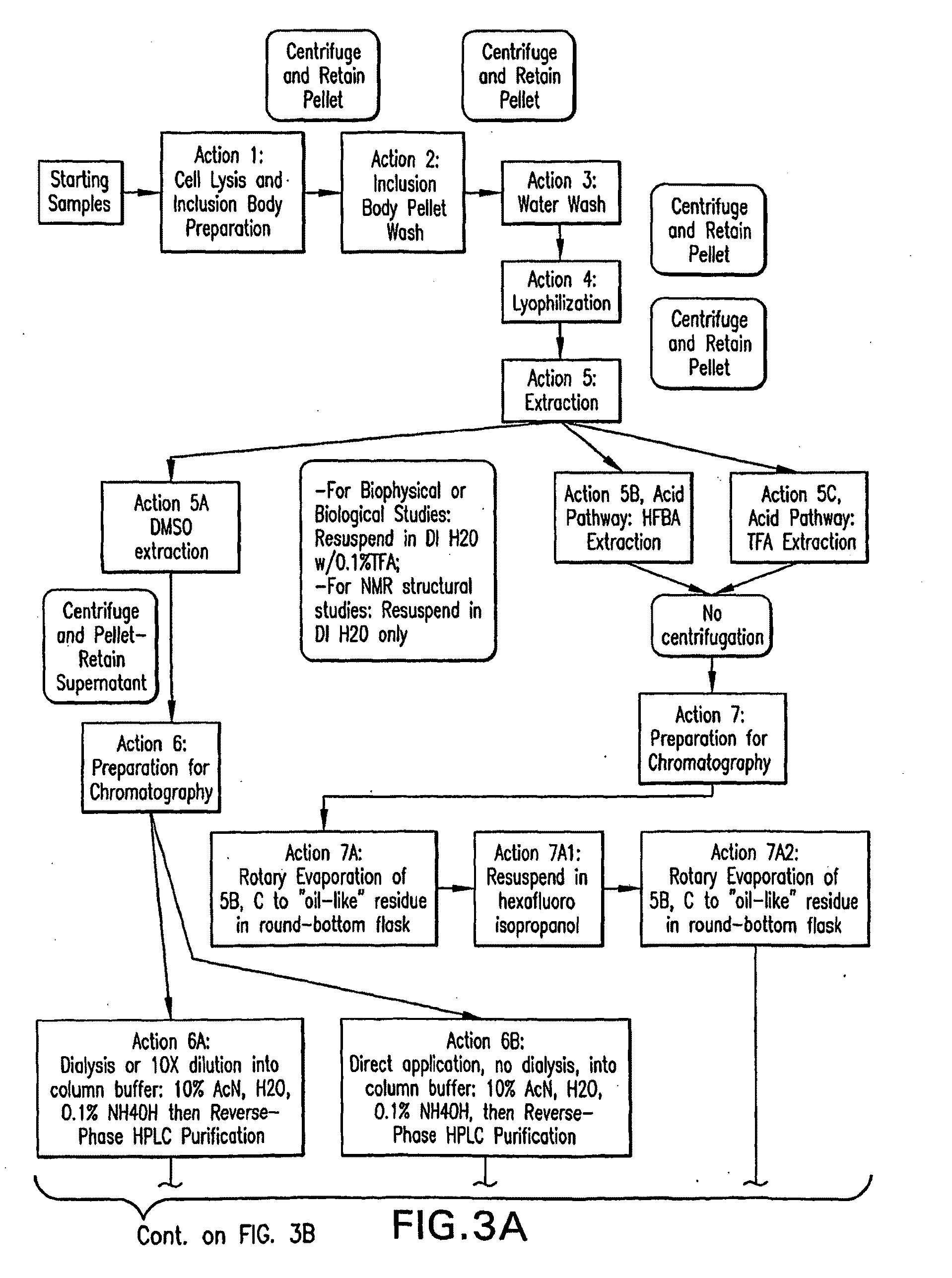Methods of preparation of recombinant forms of human beta-amyloid protein and uses of these proteins
a technology of beta-amyloid protein and recombinant forms, which is applied in the field of preparation of recombinant forms of human beta-amyloid protein and use of these proteins, can solve the problems of large uncertainty over the actual relevance of the species, and the characterization of the previous research on oligomers
- Summary
- Abstract
- Description
- Claims
- Application Information
AI Technical Summary
Benefits of technology
Problems solved by technology
Method used
Image
Examples
example i
Cloning of Abeta-Amyloid Peptide
[0169]The Abeta-amyloid peptide was synthetically constructed. In particular, FIG. 1 illustrates the DNA sequence encoding the peptide described herein as well as the amino acid sequence of the peptide. Primers that cover the sequence which codify Abeta-amyloid peptide and the desired restriction sites to clone it (see Table 2 below) on the vector pET29 were designed and used on an annealing reaction to generate the fragment that was used on a ligation reaction to the desired E. coli expression vector.
[0170]After annealing those oligos together, they were incorporated into pET29 NdeI XhoI sites by ligation using DNA ligase (Invitrogen, Carlsbad, Calif.) to form pET29-ABeta amyloid peptide [1-42] native form. The final construct was confirmed by DNA sequencing.
[0171]Beta amyloid peptides [1-39, 40, 42 and 43] were made by site directed mutagenesis (SDM) using as template pET29-ABeta amyloid peptide [1-42]. Pairs of primers SDMamy-39s and as, SDMamy-40s...
example ii
Fermentation and Expression of Beta-Amyloid
1) A-beta (1-39):
[Production of Unlabelled Material]
[0173]The expression plasmid was transformed into E. coli BL21(DE3) and plated on LB supplemented with kanamycin (50 mg / L). After incubating at 37° C. overnight, a transformant arising on the plate was used to inoculate a 150 mL M9 preculture supplemented with kanamycin at 50 mg / L. The preculture was placed on an orbital shaker (185 rpm) and incubated at 30° C. When the culture reached an OD600nm of 0.468, the entire preculture was transferred to a New Brunswick Scientific (Edison, N.J.) Micros fermenter containing 18 L of media. The fermenter media consisted of (per L) 11.32 g Na2HPO4*7H2O, 3 g KH2PO4, 0.5 g NaCl, 1 mL 1% DF-60 antifoam, 1.5 g NH4Cl, 3.55 g glucose, 2 mL 1M MgSO4, 0.1 mL 1N CaCl2, 0.02 mL FeSO4 (40 mg / mL), 2 mL kanamycin (25 mg / mL), and 0.633 mL trace element solution [per L in 5N HCl: 10 g MnSO4H2O; 10 g AlCl3H2O; 4 g CoCl2; 2 g ZnSO4 7H2O; 2 g Na2MoO4 2H2O; 1 g CuCl2 2H...
example iii
Purification of Recombinantly Expressed Beta-Amyloids
[0179]The overall schema developed for purification of the recombinant human amyloids is illustrated in FIG. 3 and described below.
Starting Samples:
[0180]The starting material for all isolated samples was cell paste frozen at −80° C. obtained from harvests of Escherichia coli cell cultures. The cell cultures originated from multiple 1 liter flask growths or from fermentor runs as large as 35 liters. The media may consist of rich media to produce unlabeled material or minimal media, with or without added labels used to prepare variously labeled samples of A-beta. Either flask or fermentor run may be used with the different media.
ACTION 1: Cell Lysis and Inclusion Body Preparation
[0181]Frozen cell paste was removed from the bottle and added to 5-10 volumes of cold lysis buffer in a beaker placed on a stirring plate placed at room temperature. The lysis buffer consisted of 100 mM tris final pH 7.5 to 7.8 at 4° C. For cell pastes deri...
PUM
| Property | Measurement | Unit |
|---|---|---|
| Lattice constant | aaaaa | aaaaa |
| Fraction | aaaaa | aaaaa |
| Fraction | aaaaa | aaaaa |
Abstract
Description
Claims
Application Information
 Login to View More
Login to View More - R&D
- Intellectual Property
- Life Sciences
- Materials
- Tech Scout
- Unparalleled Data Quality
- Higher Quality Content
- 60% Fewer Hallucinations
Browse by: Latest US Patents, China's latest patents, Technical Efficacy Thesaurus, Application Domain, Technology Topic, Popular Technical Reports.
© 2025 PatSnap. All rights reserved.Legal|Privacy policy|Modern Slavery Act Transparency Statement|Sitemap|About US| Contact US: help@patsnap.com



